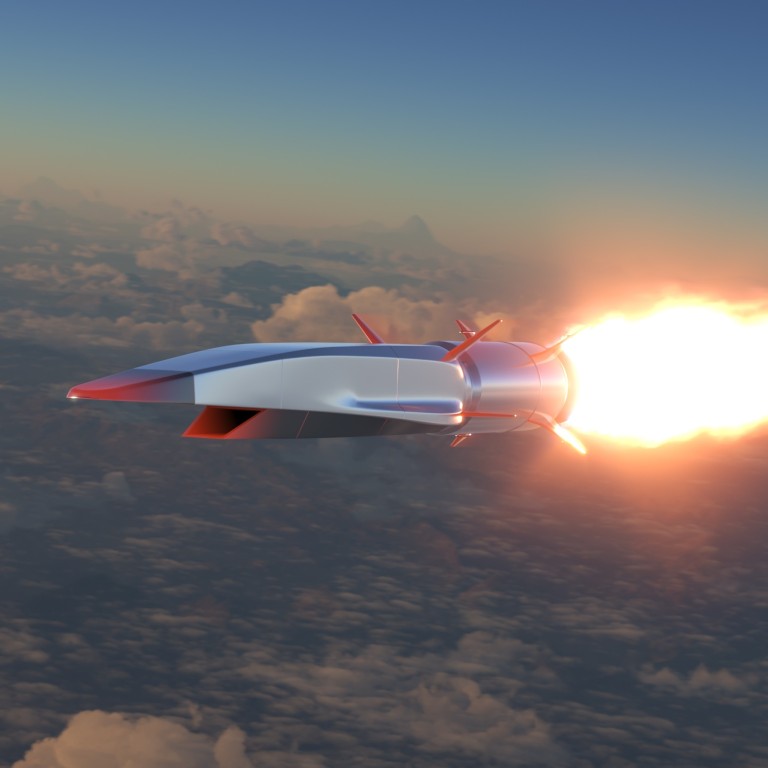
Hypersonic Race 2.0: China tests next-gen ‘waverider’ with revolutionary technology
- Chinese scientists have announced the successful test of a surface material for hypersonic vehicles previously thought impossible to create
- The achievement means China has pushed ahead of the US in the hypersonic race as America continues to struggle with thermal issues
This technology was previously thought impossible.
The smooth, non-ablative surface not only kept critical components inside the aircraft cool, but allowed wireless signals to go in and out freely, making target identification and communication possible throughout the flight, according to analysis of telemetry data.
“The test flight ended in a complete success,” the team wrote in a paper published in the peer-reviewed journal Physics of Gases last month. They did not reveal the time and location of the test.

Such new thermal protection technology could help in the development of another generation of reusable hypersonic vehicles with “longer range and faster speed, and constantly break through the boundary of flying”, wrote the team led by Ai Bangcheng, deputy director of the China Academy of Aerospace Aerodynamics in Beijing.
And with space shuttles and re-entry capsules, thermal tiles were added which could burn and take away heat.
But these hypersonic flights were short, usually lasting just a few minutes.
Nasa and the US military have launched numerous projects in the past to develop hypersonic vehicles that could make long-distance flights regularly, like jet planes.
Putin’s ‘unstoppable’ Kinzhal missile performs poorly despite hype: UK intel
In recent years, the US government has revived its hypersonic programme but has continued to suffer setbacks. According to a report to politicians by the US Congressional Budget Office in January, thermal damage remained the biggest headache to American hypersonic weapon developers.
“The fundamental remaining challenge includes managing the extreme heat that hypersonic missiles are exposed to by travelling at high speeds in the atmosphere for most of their flight,” the report said.
“Shielding hypersonic missiles’ sensitive electronics, understanding how various materials perform and predicting aerodynamics at sustained temperatures as high as 3,000 degrees Fahrenheit (1,650 degrees Celsius) require extensive flight testing. Tests are ongoing, but failures in recent years have delayed progress.”
The US appeared to still be struggling at the first stage of the hypersonic race, according to the Chinese researchers.
“The old concept of thermal barrier mainly referred to the high temperature conditions encountered by a vehicle when flying at high speeds. The main concern and challenge was the problem of heat protection at high temperatures,” Ai’s team said in the paper.
China has passed this stage. Many hypersonic missiles are already in use by China’s military, with some designed to hit a moving target, such as an aircraft carrier, with unpredictable manoeuvring from a long distance.
To the military, these hypersonic aircraft can carry out reconnaissance missions, drop bombs, intercept stealth aircraft such as the F-22, or transport a small group of special ops to any location on the planet in an hour or two.
But this would require a fundamentally different approach to heat management, according to Ai’s team.
Opinion: Global arms race for hypersonic missiles must be halted
In such an extreme environment, molecules in the air would break down and start chemical reactions with surface material.
How Ai’s team managed to keep the waverider surface intact remains a secret, but in the paper the scientists listed several possible options such as polishing the surface to extremely smooth conditions; adding some elements such as niobium, molybdenum and boron to resist ablation; redesigning the structure of the surface component completely to reduce weight; and converting the harmful heat to propulsion thrust with a liquid medium.
These technologies mostly remain in laboratories in other countries, including the United States, they said.
In China, some key methods have reached the technological readiness levels (TRLs) of up to 8, which means the system has been completed and qualified in an operational environment, according to the researchers.
That is just one step away from the final approval for field deployment.
The term “hypersonic flight” was first coined by Qian Xuesen, a founding scientist of the legendary Jet Propulsion Laboratory in the US, in a 1946 paper.
After returning to his homeland and starting China’s rocket programme, Qian proposed a practical method to convert big engineering challenges in thermal barriers to scientific questions that can be solved by a large number of scientists from different academic backgrounds.
“Master Qian’s idea is still being used in the design of active heat protection today,” Ai’s team said.
China has conducted more hypersonic test flights in a year than the US did in a decade, according to the Pentagon.
US, Japan to develop hypersonic missile interceptor
In 2021, Chinese military flew a hypersonic vehicle around the globe, surprising the US military with technology reportedly “defying the laws of physics”.
Meanwhile in May, a suborbital space plane completed its second flight and landed in a military airport in the Gobi Desert.
In response to public queries as to why no photos were available, the Chinese space authorities said that the hypersonic vehicle had used some technology “too advanced for public display”.



